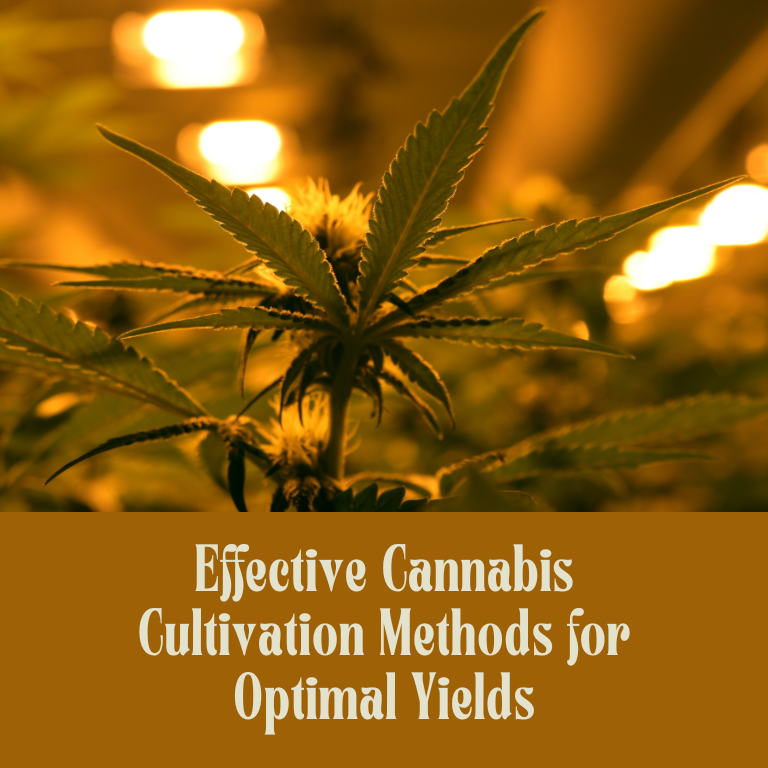Effective Cannabis Cultivation Methods for Optimal Yields

Cannabis cultivation has evolved significantly over the years, moving from small-scale, often clandestine operations to large, regulated commercial enterprises. As the demand for both medicinal and recreational cannabis continues to grow, so does the need for effective cultivation methods that ensure optimal yields and high-quality products. This article explores the most effective cannabis cultivation methods, focusing on maximizing yield, quality, and efficiency.
Understanding Cannabis Growth Phases
Before delving into specific cultivation methods, it’s essential to understand the basic growth phases of the cannabis plant. Cannabis undergoes several distinct stages: germination, seedling, vegetative, and flowering. Each stage requires specific conditions and care to optimize growth and yield.
Germination: This initial stage involves the sprouting of seeds. It requires moisture, warmth, and darkness to trigger the seeds to sprout.
Seedling: As the plant develops its first true leaves, it enters the seedling stage. This phase requires ample light and a nutrient-rich environment to support growth.
Vegetative: During this stage, the plant focuses on growing in size and developing a robust structure. Ample light, nutrients, and water are crucial.
Flowering: The final stage involves the development of buds, which are harvested for their cannabinoids and terpenes. Light cycles, temperature, and humidity must be carefully controlled during this phase.
Cultivation Methods
There are several cultivation methods used in the cannabis industry, each with its advantages and challenges. The choice of method often depends on factors such as budget, space, climate, and specific cultivation goals.
1. Soil Cultivation
Soil cultivation is one of the most traditional and accessible methods for growing cannabis. It involves planting cannabis seeds or clones in soil, which provides a natural medium rich in nutrients. This method is particularly suitable for outdoor cultivation, where natural soil conditions can support plant growth.
Advantages:
- Easy to manage and suitable for beginners.
- Soil acts as a natural buffer, reducing the risk of nutrient burn.
- Outdoor soil cultivation can be cost-effective.
Challenges:
- Soil quality varies and may require amendments.
- Risk of pests and diseases.
- Outdoor grows are dependent on local climate and weather conditions.
2. Hydroponics
Hydroponics involves growing cannabis in a nutrient-rich water solution rather than soil. This method allows for precise control over nutrient delivery and can result in faster growth and higher yields.
Advantages:
- Faster growth rates and higher yields.
- Precise control over nutrients and pH levels.
- Reduced risk of soil-borne pests and diseases.
Challenges:
- Requires significant initial investment in equipment.
- Higher maintenance and monitoring requirements.
- Vulnerable to system failures (e.g., pump failures can lead to plant loss).
3. Aeroponics
Aeroponics is a highly advanced cultivation method where plants are suspended in the air, and their roots are misted with a nutrient solution. This method maximizes oxygen exposure to the roots, promoting rapid growth and nutrient uptake.
Advantages:
- Very efficient water and nutrient use.
- Maximizes oxygenation of roots, enhancing growth.
- Can produce high yields with minimal space.
Challenges:
- High initial setup costs and technical complexity.
- Requires continuous monitoring and maintenance.
- Vulnerable to system malfunctions, which can quickly damage plants.
4. Greenhouse Cultivation
Greenhouses provide a controlled environment that combines the benefits of both indoor and outdoor cultivation. They use natural sunlight supplemented with artificial lighting and climate control systems to optimize growing conditions.
Advantages:
- Controlled environment reduces the risk of pests and diseases.
- Energy-efficient compared to full indoor setups.
- Can extend growing seasons and support multiple harvests per year.
Challenges:
- High initial construction and setup costs.
- Requires expertise in managing climate control systems.
- Can be affected by extreme weather conditions.
Best Practices for Optimal Yields
Regardless of the cultivation method chosen, certain best practices can help maximize cannabis yields:
Nutrient Management: Providing the right balance of nutrients at each growth stage is crucial. Over-fertilization can harm plants, while under-fertilization can stunt growth. Regular testing of soil or solution pH and nutrient levels is essential.
Lighting: Cannabis plants require specific light cycles for vegetative growth (16-18 hours of light) and flowering (12 hours of light). The intensity and spectrum of light should be adjusted based on the plant’s growth stage.
Temperature and Humidity Control: Maintaining optimal temperature (70-85°F) and humidity levels (40-70%) is vital for plant health. Excessive heat can stress plants, while high humidity can lead to mold and mildew.
Pruning and Training: Techniques such as topping, fimming, and low-stress training (LST) help shape the plant, promote airflow, and increase light penetration to lower buds, boosting overall yield.
Pest and Disease Management: Implementing integrated pest management (IPM) strategies can prevent infestations and diseases. This includes regular inspection, biological controls, and the use of safe, organic pesticides.
Harvest Timing: Harvesting cannabis at the right time is crucial for maximizing potency and yield. Trichomes (the tiny resin glands on the buds) should be closely monitored for maturity, with most cultivators aiming to harvest when they are cloudy with a few amber trichomes.
Effective cannabis cultivation requires a combination of the right growing methods, environmental control, and careful monitoring. By choosing the appropriate cultivation method and adhering to best practices, growers can achieve optimal yields and high-quality cannabis. As the industry evolves, ongoing research and innovation will continue to refine these methods, offering new opportunities for cultivators to enhance their production.











